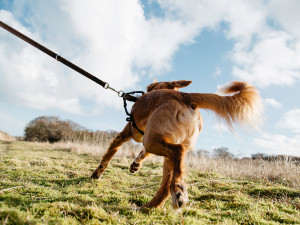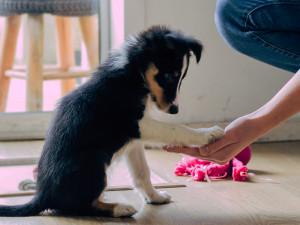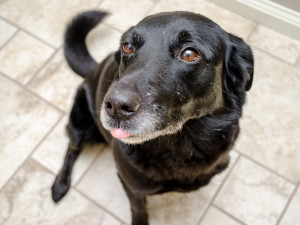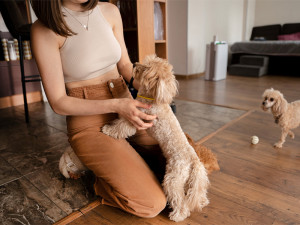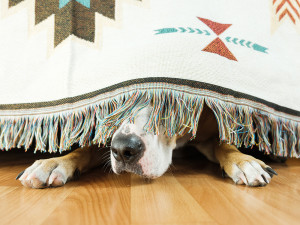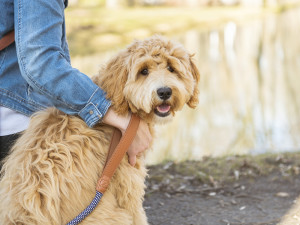The Reasons Behind Dogs’ Love For Belly Rubs
If one hand isn’t stroking a furry dog belly, what are you doing?
People love to see a dog relishing the experience of getting a belly rub because the dog is clearly enjoying it so much; it can be truly heart-melting to watch — but why do they love it that much?
Why do dogs like belly rubs?
The average dog loves a belly rub, though that same dog probably doesn’t like being called ‘average’. There are many reasons why dogs like belly rubs so much — some physical and some emotional.
The physical reasons why dogs like belly rubs include:
Mammals, including dogs, have a sensitive type of neuron that responds to stimulation of their hair follicles, so stroking feels good. The evolutionary basis for a pleasurable feeling related to hair follicles may be that if it feels good to groom (socially or individually) then good hygiene and all its benefits will be more likely to occur. The soft hairs on the belly may be especially prone to stimulating the neurons that lead to this pleasurable feeling.
Dogs can’t easily reach their belly, so belly rubs offer them a pleasant feeling they can’t achieve on their own.
Belly rubs stimulate circulation, which feels good to dogs. The extra blood flow to the area being rubbed helps dogs feel better. That can be especially true if a dog has gas or an upset stomach because the extra blood flow can offer relief.
The emotional reasons why dogs like belly rubs include:
Rubbing your dog’s belly, like other forms of stroking, releases endorphins that make your dog feel good and enhances their mood. These chemicals can even help relieve pain.
One of the chemicals released is oxytocin, a powerful substance that impacts bonding in many mammals including humans and dogs. This hormone also enhances love and connection between human mothers and their babies, and even shows up in romantic love.
Belly rubs can lower cortisol levels in your dog (and you), which means that belly rubs can relieve stress and lead to higher levels of relaxation.
All these factors together mean that belly rubs can help you and your dog bond, strengthen your relationship with each other and make you feel more connected to one another. The comfort and reassurance belly rubs provide our dogs are a result of the effects of this physical contact on their physiology. That’s right, belly rubs allow your dog better living through chemistry.
Can dog belly rubs be used as a training reward?
Yes, belly rubs can be used as a training reward if and only if we are talking about a dog who enjoys them. Belly rubs are not always a great option for training sessions because it is easier to use treats, chews, toys or a play session when you are doing multiple repetitions of a skill. But if your dog absolutely adores belly rubs, you can reinforce your dog for doing what you ask in a real-life situation. If your dog does a great ‘stay’, comes when called, performs a trick or does something else you really like, a belly rub can be the positive reinforcement you offer to make it more likely they exhibit that behaviour again.
Is there a specific reason dogs expose their bellies?
There is more to apparent requests for belly rubs than meets the eye. Just because a dog rolls on to their back does not mean that the dog is asking for a belly rub or even wants one. So, why do dogs present their bellies? It’s a simple question, but like many questions when it comes to dog behaviour, there is not a simple answer. We have to make our conclusions based on our observations of dogs and our knowledge of dog behaviour.
If you want to be a part of the belly rubbing fun, it’s critical to know when a dog likes a belly rub and when they don’t — because not all dogs like them. Even dogs who enjoy belly rubs may not want one all the time, and it’s important to distinguish dogs who are on their back exposing their bellies who want a belly rub, and those in that position who emphatically do not. To know the difference is all about reading body language, understanding dog behaviour and visual signals, and doing your best to understand and communicate with your dog.
One other possibility is they are showing their belly as an appeasement signal, which means they are indicating they pose no threat. Dogs who lie on their backs to indicate appeasement tend to be a little tense. They may show signs of stress such as tongue-flicking, a fear grimace, a tucked or tense tail or avoiding your gaze.
If you attempt to give a belly rub to a dog who is presenting their underside as a form of appeasement, they will likely become more tense or possibly upset because you are touching them in a way they do not want and are not asking for. Lying on their backs in this way is a social signal, not a request for physical contact. It’s an indication that they’re not challenging you and is often behaviour you’ll see in a dog who is uncomfortable, socially speaking.
Dogs seeking a belly rub are more likely to be relaxed all over, have a mouth that is open and relaxed with their tongue hanging out, a loosely wagging tail, and are more likely to look at you with squinty eyes. They are likely to relax even more when given a belly rub and may even paw at you for more if you stop.
Can belly rubs be beneficial for strengthening the human-dog bond?
Any activity enjoyed together and by mutual consent can be good for the relationship. Stroking our dogs, including belly rubs, offers an opportunity for a positive feedback loop of oxytocin and bonding. The more we connect, the more we both produce oxytocin, and the oxytocin makes us feel closer to each other. Stroking is practically magical with its power to make us feel closer to each other, to lower our blood pressure and to release stress. It’s not an exaggeration to say that belly rubs (like other stroking of our dogs) is good for our relationship and enhances our quality of life as well as theirs.
How to rub a dog’s belly
As individuals, dogs like different types of physical contact, and those variations in preferences apply to belly rubs. The best way to give your dog a belly rub they will enjoy is to pay attention to how they respond to what you are doing and to adjust accordingly. Try either long strokes, circular motions with and without using your nails, or gentle pats for a few seconds. Watch your dog’s response to each of these belly rub styles before taking a little break to see if they walk away or seem to invite more by pawing at you, staying in place or open their posture even wider. If they relax into your motions, sigh, or ask for more when you stop, chances are you are doing something they like.
Are there any alternatives for dogs who don’t like belly rubs?
Not all dogs like belly rubs. Perhaps it doesn’t feel good, or maybe they feel too vulnerable to expose their underside. Some may be ticklish, and others may have had a negative experience with a belly rub. Whatever the reason may be, don’t try to rub the belly of a dog who doesn’t want you to, whether it’s your own dog or someone else’s.
Start slowly and gently and if the dog seems uncomfortable in any way, immediately stop. If your dog prefers to have their chest or their ears be the focus of your attention, then stroke them there. If they shy away from any physical contact, respect their feelings and interact in ways they enjoy. It’s simple — if your dog doesn’t like belly rubs, stroke them how they like to be stroked, and if they don’t like physical contact of any kind, respect that and don’t force them.
Many dogs love belly rubs, and that’s great for people, because many of us love to give them belly rubs. Dogs look mind-bendingly endearing when they roll over on their backs, mouths flopping around, tails wagging and generally enjoying themselves. Belly rubs can be a great way to bond with your dog and show them affection – if they like them, who are we to deprive them of this pleasure in life?


